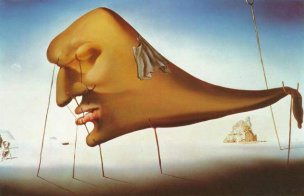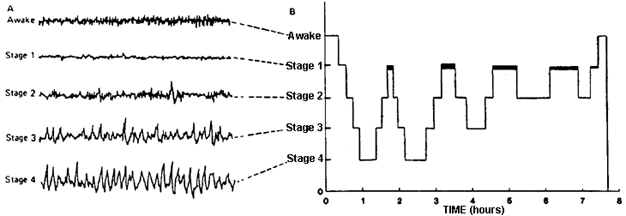A web site full of stuff that should be useful
| AS Psychology |
| Core Studies |
| Links |
| Course Content |
| Exam Questions |
| Psychological Investigation |
| Themes and Perspectives |
| Glossary |
| About this site |
| Stuff |
| For Teachers |
|
Dali (1937) Sleep
|
![]()
Dement, W. & Kleitman, N. (1957).
The Relation of Eye Movements During Sleep to Dream Activity: An Objective Method for the Study of Dreaming.
Background It
is possible to see at times the eyes of a sleeping person moving. These periods of prolonged rapid eye movements (REM) were
thought by Dement and Kleitman to have some connection with
dreaming. It
seems that all humans dream but dreams are easily forgotten. Freud argued that the function of dreaming was to preserve
sleep by unconsciously fulfilling wishes which would otherwise upset
and therefore disturb the sleeper.
Freud therefore argued that dreams are the ‘royal road to
the unconscious’, meaning that dreams allow therapists to have an
insight into their clients’ unconscious thoughts.
More
recently, psychologists have focused on cognitive and physiological
explanations for dreaming. For
example a cognitive approach might explain how dreaming is a way of
dealing with our problems such as those relating to work and
personal life. Whereas a physiological approach might explain
dreaming as the result of random firing of neurones which create an
image which we then put meaning to. During
a typical night a sleeper passes through different levels of sleep
in a cyclic fashion between 5 and 7 times.
Level 1 and 2 are light sleep characterised by irregular EEG
patterns. Level 3 and 4
are deeper levels and are characterised by regular wave patterns.
Stage 4 is called slow wave sleep or deep sleep.
After stage 4 the sleeper goes back up the ‘sleep
staircase’ to stage 2 and there is a period of REM sleep lasting
for about 15 to 20 minutes. These
sleep states alternate during the night starting with a rapid
descent into deep sleep, followed by progressively increased
episodes of lighter sleep and REM sleep. Note that the shaded are are REM sleep Aim
The
aim of the study was
to investigate the relationship between eye movements and dreaming. The study had three hypotheses:
Procedure/Method The
nine participants were seven
adult males and two adult females. Five
were studied intensively, while only a small amount of data was
collected on the other four just to back up the findings of the main
five. The
participants were studied under controlled laboratory conditions,
whereby they reported to the laboratory just before their usual
bedtime. They had been
asked to eat normally but to avoid caffeine or alcohol on the day of
the study. The
participants went to bed in a quiet, dark room. An
electroencephalograph
(EEG) was used to amplify and record the signals of electrodes which
were attached to the participants face and scalp.
Two or more electrodes were attached near to the
participants’ eyes to record electrical changes caused by eye
movement. Two or
three further electrodes were attached to the scalp to record brain
activity which indicated the participants’ depth of sleep.
The participants then went to bed in a quiet, dark room.
Testing
Hypothesis 1
(there will be a significant association between REM sleep and dreaming) At
various times during the night (both during REM and N-REM sleep) the
participants were awakened to test their dream recall.
The participants were woken up by a loud doorbell ringing
close to their bed. The
participant then had to speak into a tape recorder near the bed.
They were instructed to first state whether or not they had
been dreaming and then, if they could, to report the content of the
dream. The participants
were only recorded as having dreamed if they were able to relate a
coherent and relatively detailed description of the dream content.
Different participants were woken according to different schedules. Two were woken at random. One was woken three times in REM followed by three times in N-REM and so on. One was woken randomly but was told that he would only be woken during REM. Another was woken at the experimenter’s whim. In an attempt to eliminate the possibility of experimenter effects, the experimenter did not communicate with the participants during the night. Furthermore to help prevent bias the participants were never told, after wakening, whether their eyes had been moving or not.
Testing
Hypothesis 2
(there will be a significant positive correlation between the estimate of the
duration of dreams and the length of eye-movement) The participants were also woken up either five minutes or fifteen minutes into a REM period, and asked to say whether they thought they had been dreaming for five or fifteen minutes.
Testing
Hypothesis 3
(there will be a significant association between the pattern of eye movement and
the context of the dream) The participants were woken up as soon as one of four patterns of eye movement had lasted for at least one minute. On waking, the participant was asked to describe in detail the content of their dream. The four patterns that prompted an awakening were: (a) mainly vertical eye movements; (b) mainly horizontal eye movements; (c) both vertical and horizontal eye movements; (d)
very little or no eye movement.
Results/Findings
All
the participants showed periods of REM every night during sleep. The REM EEG was characterised by a low voltage, relatively
fast pattern. In
between REM periods the EEG patterns were either high-voltage, slow
activity or spindles with a low-voltage background, both
characteristic of deeper sleep.
REM never occurred at the beginning of the sleep cycle REM
periods which were not terminated by an awakening varied between 3
minutes and 50 minutes with a mean of about 20 minutes, and they
tended to increase in length as the night progressed.
The REM periods occurred at regular intervals during the
night, though each participant has their own pattern:
the mean period between each REM phase for the whole group
was 92 minutes, with individual norms varying between 70 minutes and
104 minutes. Results relating to hypothesis 1 (there will be a significant association between REM sleep and dreaming) Table showing the incidences of dream recall after awakenings during periods of REMs or periods of NREMS
The
results show that REM sleep is predominantly, though not
exclusively, associated with dreaming, and N-REM sleep is associated
with periods of non-dreaming sleep. Nearly
all dream recall in N-REM awakenings occurred within eight minutes
of an REM, suggesting that the dream might have been remembered from
the previous REM Results
relating to hypothesis 2
(there will be a significant positive correlation between the estimate of the
duration of dreams and the length of eye-movement) Results
of dream-duration estimates after 5 or 15 minutes of rapid eye
movements
Estimates (in minutes) Estimates (in minutes) after 5 minutes REM after 15 minutes REM
Subject Right Wrong Right Wrong
DN 8 2 5 5 IR 11 1 7 3 KC 7 0 12 1 WD 13 1 15 1 PM 6 2 8 3
Total 45 6 47 13
The series of awakenings which were carried out to see if the participants could accurately estimate the length of their dreams, revealed that all the participants were able to choose the correct dream duration fairly accurately, except for one participant who could only recall the latter part of the dream and so underestimated its length. Results relating to hypothesis 3 (there will be a significant association between the pattern of eye movement and the context of the dream) There
did appear to be some relationship between the dream content and the
type of eye movements. Periods
of pure vertical or horizontal eye movements were rare, but when the
participant was woken up after a series of vertical
eye movements they reported dreams such as: Ø
standing at the
bottom of a cliff operating a hoist, and looking up at the climbers,
and down at the hoist machinery. Ø climbing up a series of ladders looking up and down as he climbed. Ø throwing basketballs at a net, first shooting and looking up at the net, and then looking down to pick another ball off the floor. In
the only instance of horizontal
eye movements, the dreamer was watching two people throwing
tomatoes at each other. In
the 21 awakenings after a mixture of eye movements, participants
were always looking at people or objects close to them (e.g.
talking to a group of people, looking for something, fighting with
someone), there was no recall of distant or vertical activity. In
the 10 instances where the participants showed little or no eye
movements, the dreams involved the dreamer watching something at a
distance or just staring fixedly at some object. In
order to confirm the meaningfulness of these relationships, 20 naive
participants and 5 of the experimental participants were asked to
observe distant and close-up activity while awake.
These measurements were in all cases comparable to those
occurring during dreaming. Evaluation of Procedure An obvious weakness of the
study is its lack of ecological validity.
The situation in which the participants had to sleep was
unusual and could have affected their sleep patterns.
Also the nature of the method of waking participants may have
affected their ability to recall their dream.
A
further problem with the study was the sample size.
The sample size was small and only included 2 females so we
could argue that the results were biased towards the dream pattern
of men rather than women.
Subsequent studies have found that there are large
differences between individuals in the reports of dreaming during
REM. Subsequent
studies have not supported Dement and Kleitman’s findings that
there is a relationship between eye movements and what the person is
dreaming about. However
the method was very tightly controlled.
For example the researchers were able to control the
location, sleeping time and the participants use of stimulants.
Reference Dement, W. & Kleitman, N. (1957) The relation of eye movements during sleep to dream activity: An objective method for the study of dreaming. Journal of Experimental Psychology, 53, 339-46
GROSS, R. (1999) Key Studies in Psychology, 3rd Edition. London: Hodder and Stoughton BANYARD, P. AND GRAYSON, A. (2000) Introducing Psychological Research; Seventy Studies that Shape Psychology, 2nd Edition. London: Macmillan
|
|||||||||||||||
|
|
|||||||||||||||

